
3 minute read
What Constitutes a Good Muslim Rep in Books?
Muslims need to know about the Riz Test and use it when deciding on buying books
BY AMANI SALAHUDEEN
Advertisement
With the constant oversaturation of books every year, one must understand how to look for those that have good Muslim representation (hereinafter “rep”) when selecting them. Even today it’s hard to find novels with practicing Muslim protagonists or talking about their relationship with Islam. Although the community isn’t a monolith, the average practicing Muslim shares certain core values.
Good Muslim rep doesn’t mean that it reflects my personal experience or only positive experiences. Selecting the right books depends on the readers and how observant they are.
Prime examples of good Muslim rep books are those that don’t present a negative portrayal of those who are conservative or struggling to practice. Some novels talk about Sunnis and others talk about Shias, which is something that not everyone is aware of. The best way to decide what constitutes good Muslim rep books is to figure out if the character practices Islam.
According to Bashirat Oladele, Muslim authors must write with a diverse community in mind. From his perspective, a good rep of Muslims in novels occurs when authors avoid the typical stereotypes. Oladele emphasizes the importance of seeing Muslims as people, as opposed to terrorists. “How about we focus on representing Muslims who enjoy being Muslim and have interests outside their identity as a Muslim? In the West, struggle is a part of the Muslim experience, but by no means does it define the Muslim experience — whatever that may be because we are all diverse individuals going on different journeys. Not to dismiss those who like the ‘captain saves a hijabi’ narrative, but it is old and overdone. I will be mainly speaking about fiction books [novels] because it is what I enjoy reading, but prior to this I need to shout out It’s Not About the Burqa. Shortlisted, rightfully so, as ‘Foyles Non-Fiction Book
of the Year’ in 2019, it touches upon topics such as mental health, sex, identity, and finances” (https://theboar.org/2020/08/ representation-muslims-in-literature/).
The Riz Test — inspired by actor Riz Ahmed’s 2017 speech in the House of Commons on diversity on screen, it contains five criteria to measure how Muslims are portrayed on film and TV — is the best way to evaluate a book or media piece’s accurate portrayal of Muslims. It does this by answering five questions: “If the film/show stars at least one character who is identifiably Muslim (by ethnicity, language or clothing), is the character talking about, the victim of or the perpetrator of terrorism? •
Presented as irrationally angry? • Presented as superstitious, culturally backwards or anti-modern? • Presented as a threat to a Western way of life? • If the character is male, is he presented as misogynistic? or if female, is she presented as oppressed by her male counterparts?” (https://www. riztest.com/).
If any of the above are “Yes,” then it has failed the Riz Test. For example, in
Huda Fahmy’s “Huda F Are You?” she draws a cartoon version of herself to tell her story. Her graphic novel passes the test and even shows her immigrant parents in a more positive light than mainstream media usually do. It was truly heartwarming to see that kind of representation in this Own Voices book told from a young
Huda’s perspective. It discusses periods, hate crimes, relationships (both platonic and conversations Huda has with her husband). She also explains why she decided to title it “Huda F Are You?”
Another good example is Sara Sharaaf
Beg’s “Salaam, With Love,” a story about exploring growth in faith. The protagonist,
Du’a, is a child of immigrant parents who both argues and gets along with them — rather refreshing to see in a coming-ofage story. Throughout the novel,she prays either at home or the masjid. I loved how her family celebrated Ramadan. Du’a struggles a bit with balancing culture, religion and who she wants to be. It was also incredible to see a large Muslim family in a novel.
One of the most memorable quotes is, “There is no faith without trust, and there










